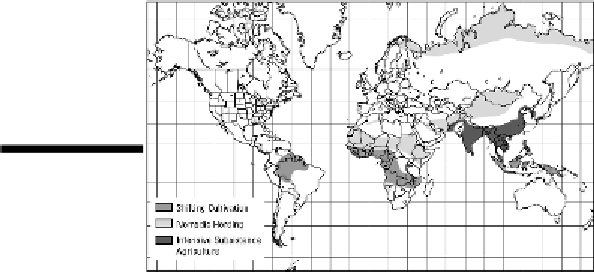Geography Reference
In-Depth Information
Subsistence economies
Subsistence economies
are characterized by consumption of goods by the people or groups
that produce them. Buying and selling is rather limited, and tertiary and quaternary activities
are rare-to-unknown. Traditional societies that rely on manual labor and possess low levels
of technological sophistication are typical of this type of economy. Four kinds of subsistence
economies are commonly recognized and are discussed in the following sections.
Hunters and gatherers
Hunters and gatherers
subsist on wildlife, fish, and/or parts of plants (roots, nuts, or berries) that
grow wild. Contrary to a one-liner about a very different kind of work, this is unquestionably the
world's oldest profession. Indeed, eons ago, before the discovery of agriculture, everybody did this.
Today hunters and gatherers are few in number and are found mainly in isolated areas of tropical rain-
forest (Figure 15-4).
Figure 15-4:
A
generalized geo-
graphy of sub-
sistence
eco-
nomies.
Nomadic herders
Nomadic herders
tend domesticated herbivores (including sheep, goats, cattle, and reindeer) that feed
on natural foliage during the course of a controlled itinerary (wandering).
Steppe
(grasslands) and
tundra are the traditional realms of these people, sometimes called
pastoral nomads.
The global pop-
ulation of these folk is rapidly decreasing as farming occupies more land, and as people turn to
ranch-
ing
— the raising of livestock in fixed locales for sale instead of consumption. Also, governments



